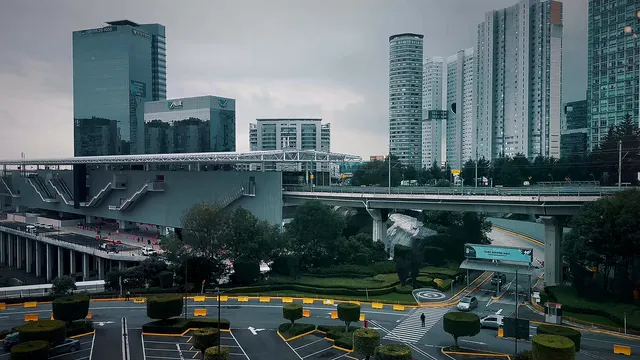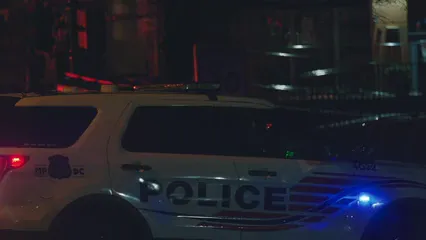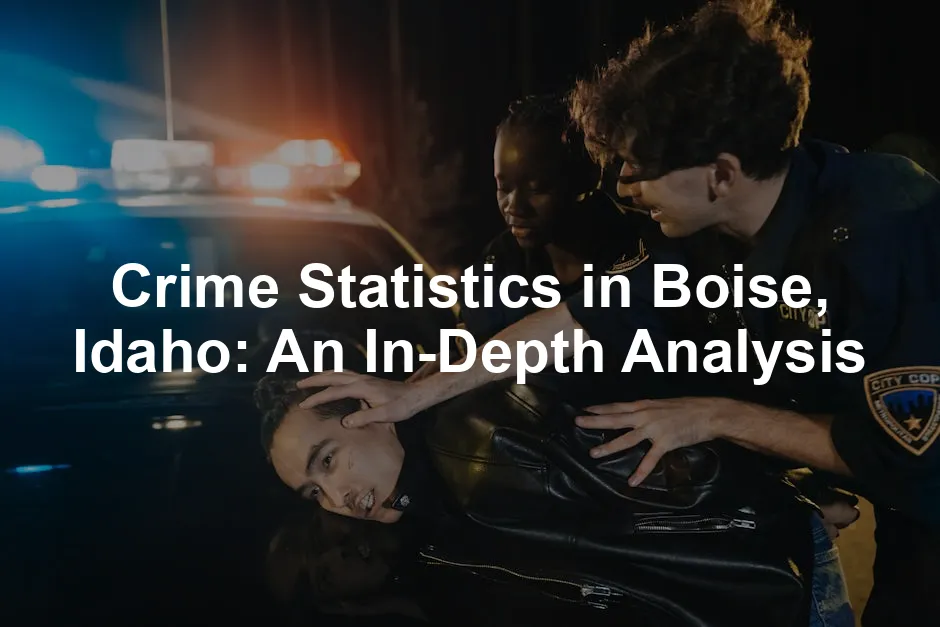Introduction
Understanding crime statistics in Boise, Idaho, is essential. For residents, potential movers, and policymakers alike, these numbers tell a story. They reveal trends, patterns, and a community’s overall safety. A closer look at crime statistics can help residents feel secure or inform decisions about relocating to this charming city.
Boise, known for its beautiful scenery and friendly atmosphere, also faces challenges typical of any urban area. Insight into crime rates helps highlight ongoing issues and successful initiatives. This article will dive into historical crime trends, current statistics, and the implications for community safety. By examining data from various sources, we aim to provide a comprehensive view of crime in Boise, including comparisons to other cities and an analysis of how these statistics reflect community concerns.
If you’re intrigued by the history of crime in America, check out “The Crime Book: A History of Crime in America” by Paul L. Williams. This gripping read provides an eye-opening journey through the criminal underbelly of our nation, revealing how crime has evolved and shaped society.

Historical Crime Trends in Boise
Overview of Crime Data
Crime rates in Boise have shown significant changes over the past two decades. In 1992, the violent crime rate was 3.97 per 1,000 citizens. Fast forward to 2020, that number dropped to 2.49. This trend illustrates a steady decline in violent crime in the city. Conversely, property crime rates have fluctuated more dramatically, peaking at 54.93 in 1994 but decreasing to 16.84 by 2020.
Data from the City of Boise, NeighborhoodScout, and AreaVibes reveal that the overall crime rate is 38% lower than the national average. In 2022, the total crime rate was 14.66 per 1,000 residents, with violent crime at 2.5 per 1,000 and property crime at 12.16 per 1,000. This highlights Boise’s relative safety compared to national figures, where the violent crime rate sits at 4 per 1,000 and property crime at 20 per 1,000.
Historically, Boise’s crime rates have shown resilience, adapting to social changes and law enforcement strategies. The consistent efforts by local law enforcement and community programs have contributed to these positive trends.

Violent Crime Trends
The trends in violent crime in Boise tell a compelling story. Over the years, violent crime rates have generally decreased. In 2017, the violent crime rate was 2.79 per 1,000 citizens, while in 2020, it hit 2.49. This downward shift illustrates a commitment to public safety and community well-being.
Breaking down the statistics further, murder rates remain low, with only three reported in 2022. Rape incidents, however, have shown some fluctuations, with 186 reported in 2022. Robbery and assault also contribute to the violent crime landscape, with 46 robberies and 356 assaults recorded in the same year. Comparatively, these figures are significantly lower than the national averages.
For context, the national average for violent crime is approximately 4 per 1,000 residents. This means Boise is not just safer than many cities, but also demonstrates effective policing strategies and community engagement efforts. The decline in violent crime is encouraging, indicating a safer environment for Boise’s residents and visitors alike.

If you want to dive deeper into the psychology of crime, consider “The Anatomy of Violence: The Biological Roots of Crime” by Adrian Raine. This book explores the biological factors that may contribute to criminal behaviors, offering a unique perspective on the issue.
Property Crime Trends
Property crime in Boise has demonstrated interesting patterns over the years. Focusing on three main categories—burglary, larceny-theft, and motor vehicle theft—provides a clearer picture of the ongoing challenges.
Burglary rates have fluctuated but showed a decline in recent years. In 2022, Boise experienced 285 reported burglaries, translating to about 1.20 incidents per 1,000 residents. This is a promising sign, as it reflects a proactive approach to community safety and law enforcement efforts.
Larceny-theft, however, remains a more significant concern. With 2,327 cases reported in 2022, the rate stands at approximately 9.83 per 1,000 residents. This statistic suggests that while violent crime may be on the decline, residents must remain vigilant against theft. The prevalence of larceny-theft highlights the need for community awareness and preventive measures.
Motor vehicle theft, though less frequent than other property crimes, still presents challenges. In 2022, there were 266 reported incidents, equating to 1.12 per 1,000 residents. Though this number is lower than national averages, it underscores the importance of securing vehicles and parking in well-lit areas.
Several factors contribute to these trends. Population growth in Boise has led to increased opportunities for crime. Additionally, economic conditions, including job availability and housing costs, can impact crime rates. As the city continues to develop, maintaining effective law enforcement and community programs will be pivotal in addressing property crime.

In summary, while Boise’s property crime rates show some areas of improvement, vigilance and community engagement will remain essential in combating these issues. Understanding these trends is vital for residents and local authorities alike as they work together to foster a safer environment.
Comparisons with Other Cities
Crime Rate Comparisons with Similar Cities
When comparing Boise’s crime statistics with peer cities like Reno, Salt Lake City, and Spokane, the results are intriguing. Boise consistently presents a safer environment than many of its counterparts.
Reno, Nevada, with a population of approximately 255,000, has a total crime rate of about 28.3 per 1,000 residents. This figure is notably higher than Boise’s total crime rate of 14.66 per 1,000 residents. Reno’s property crime rate also outpaces Boise’s, highlighting a significant difference in safety. In fact, when it comes to violent crime, Reno’s rate stands at around 5.68 per 1,000 residents, which is substantially higher than Boise’s 2.5 per 1,000.
Salt Lake City, Utah, another city worth mentioning, has a total crime rate of approximately 38.2 per 1,000 residents. This is significantly higher than Boise’s crime statistics. Salt Lake City grapples with a violent crime rate of 7.4 per 1,000, setting a stark contrast to Boise’s much lower figures. A notable aspect is that Salt Lake has a larger urban area, which often correlates with increased crime rates.
Spokane, Washington, also showcases higher crime statistics compared to Boise. With a total crime rate of 28.8 per 1,000 residents and a violent crime rate of 5.5 per 1,000, Spokane residents face a greater risk than those in Boise. Moreover, Spokane’s property crime rate is notably high, indicating challenges in community safety that Boise does not experience to the same degree.

Overall, Boise stands out as a safer city compared to Reno, Salt Lake City, and Spokane. The city’s focus on community policing and proactive crime prevention strategies contributes to maintaining this lower crime rate, ensuring residents feel more secure.
To further expand your understanding of crime and justice, I recommend “Criminal Justice: A Brief Introduction” by Frank Schmalleger. This book provides a straightforward overview of the criminal justice system, perfect for anyone looking to get acquainted with the subject.
Analysis of Crime Index Rates in Neighboring Regions
To better understand Boise’s safety, let’s examine the crime index rates in neighboring regions. Cities like Meridian, Nampa, and Caldwell provide crucial context. Meridian, just a stone’s throw from Boise, enjoys a crime index of 76.3, making it one of the safest places in Idaho. In comparison, Nampa and Caldwell have crime indexes of 195.6 and 205.4, respectively, indicating a higher prevalence of crime.
The crime index rates in these neighboring areas suggest that Boise is not only safer than some larger cities but also more secure than many surrounding communities. A visual representation of these comparisons can be seen in the following table:
| City | Total Crime Index | Violent Crime Index | Property Crime Index |
|---|---|---|---|
| Boise | 14.66 / 1,000 | 2.5 / 1,000 | 12.16 / 1,000 |
| Meridian | 76.3 | 1.2 / 1,000 | 4.93 / 1,000 |
| Nampa | 195.6 | 3.5 / 1,000 | 14.02 / 1,000 |
| Caldwell | 205.4 | 4.0 / 1,000 | 14.95 / 1,000 |
These statistics paint a clear picture of Boise’s standing in Idaho. Residents can feel a sense of relief knowing that they live in a city with lower crime rates than both larger urban areas and nearby towns. The focus on community safety, local law enforcement engagement, and a proactive approach to crime prevention enables Boise to maintain a peaceful environment.

Community Impact and Perception of Crime
Resident Perspectives on Safety
Boise residents have varied perspectives on crime and safety, and surveys shed light on these sentiments. A recent poll indicated that 70% of locals feel there is very little crime in Boise and feel comfortable walking alone at night. This reflects a strong sense of community trust and engagement with law enforcement.
However, perceptions can differ dramatically between neighborhoods. For instance, areas closer to downtown may report higher crime rates, leading to an increased sense of concern among residents. In contrast, neighborhoods like Quail Ridge and Harrison Boulevard boast lower crime rates, allowing residents to feel safer and more secure.
Interestingly, some residents express a feeling of vulnerability despite the statistics. A survey found that 30% of respondents believe there is too much crime and would hesitate to walk the streets alone at night. This sentiment may stem from specific incidents in their neighborhoods or a broader fear of crime that persists despite the overall positive trends.

Ultimately, understanding how residents perceive safety in Boise is crucial. These insights reveal the importance of community engagement, highlighting the need for ongoing dialogues between residents and law enforcement. By addressing concerns and fostering trust, Boise can continue to ensure its residents feel safe in their city.
If you’re interested in exploring the impact of crime on society, you might find “The New Jim Crow: Mass Incarceration in the Age of Colorblindness” by Michelle Alexander a compelling read. This book addresses the systemic issues surrounding mass incarceration and its implications on race and justice, making it a crucial read for anyone interested in social justice.
Impact of Crime on Local Policies and Community Programs
Crime statistics in Boise have a notable influence on local policies and community initiatives. Law enforcement agencies analyze trends to adapt their strategies. For instance, the rise in property crime rates has prompted the Boise Police Department to enhance community policing efforts. Officers are now more visible in neighborhoods, fostering better relationships with residents.
Moreover, the Boise City Council actively engages in discussions about safety. They allocate funds to support community programs that aim to reduce crime. These programs include neighborhood watch initiatives and educational workshops focusing on crime prevention. The city emphasizes collaboration between law enforcement and community members, recognizing that engaged citizens can be powerful allies in crime reduction.
Several successful initiatives have emerged in response to crime trends. One such program is the “Safe Streets” initiative, which encourages residents to report suspicious activities. This program has led to increased awareness and vigilance among community members. As a result, the police have reported a rise in tips and leads, aiding them in addressing crime more effectively.
Another impactful program is the “Youth Outreach” initiative, targeting at-risk youth. By offering mentorship and recreational activities, the program seeks to deter young people from engaging in criminal behavior. This proactive approach has shown promise, reducing juvenile crime rates in the city.
Ultimately, the interplay between crime statistics and community responses illustrates a dynamic effort to ensure safety in Boise. As crime rates change, so do the strategies employed to maintain the city’s reputation as a safe and welcoming place to live.

Conclusion
In summary, crime statistics in Boise reveal a city that is actively addressing its safety challenges. The overall crime rate is lower than the national average, with significant reductions in both violent and property crimes. However, the data also highlight areas that require ongoing attention, particularly regarding property crime.
Monitoring crime statistics is essential for understanding community safety. It enables local authorities to make informed decisions about resource allocation and policy development. Community engagement plays a pivotal role in these efforts as well. Residents who stay informed and involved contribute to a culture of safety and vigilance.
As Boise continues to grow, the importance of collaboration between law enforcement and the community cannot be overstated. By fostering open communication and supporting local initiatives, Boise can maintain its reputation as a safe haven. Encouraging residents to participate in safety programs and discussions will help create a stronger, more resilient community.

If you’re also interested in exploring the world of crime fiction, consider “Crime and Punishment” by Fyodor Dostoevsky. This classic novel not only delves into the mind of a criminal but also explores themes of morality, guilt, and redemption.
FAQs
What are the current crime rates in Boise, Idaho?
Boise, Idaho, boasts a relatively low crime rate compared to national averages. As of 2022, the city recorded a violent crime rate of 2.5 incidents per 1,000 residents. This includes three murders and 186 rapes, alongside 46 robberies and 356 assaults. Property crime rates tell a similar story, with a total of 12.16 incidents per 1,000 residents. Specifically, there were 285 burglaries, 2,327 thefts, and 266 motor vehicle thefts. Overall, Boise’s total crime rate stands at 14.66 per 1,000, making it a safer place to live.
How does Boise compare to other cities in terms of crime?
When comparing Boise to other cities, it shines like a diamond in a coal mine. For instance, Reno, Nevada, has a total crime rate of about 28.3 per 1,000 residents, significantly higher than Boise’s 14.66. Salt Lake City, Utah, presents an even starker contrast with a total crime rate of approximately 38.2 per 1,000. Spokane, Washington, also lags behind, recording 28.8 per 1,000 residents. It’s clear: Boise offers a much safer environment, especially for those looking to escape urban crime.
What initiatives are in place to reduce crime in Boise?
Boise is proactive about crime prevention. The Boise Police Department has enhanced community policing efforts, encouraging residents to participate in local safety initiatives. Programs like “Safe Streets” empower citizens to report suspicious activities, fostering collaboration between law enforcement and the community. Additionally, youth outreach programs aim to deter at-risk youth from engaging in criminal activities, creating a safer environment for everyone. These initiatives showcase the city’s commitment to maintaining public safety.
How safe is it to live in Boise?
Living in Boise feels pretty safe for most residents. Surveys indicate that around 70% of locals feel there is very little crime, and many feel comfortable walking alone at night. However, perceptions can vary by neighborhood. While areas like Quail Ridge enjoy lower crime rates, downtown locations may spark more concern. Nevertheless, overall statistics paint a positive picture, reflecting Boise’s status as a safe and welcoming community.
What resources are available for individuals concerned about crime in Boise?
For those worried about crime, Boise offers several valuable resources. The Boise Police Department provides non-emergency dispatch services at (208) 377-6790 and encourages residents to report suspicious activity. Community watch programs enhance neighborhood safety, allowing citizens to stay alert and informed. Furthermore, local law enforcement conducts regular safety workshops to educate residents on crime prevention. These resources empower Boiseans to take an active role in their community’s safety.
Please let us know what you think about our content by leaving a comment down below!
Thank you for reading till here 🙂
All images from Pexels




